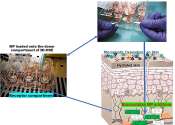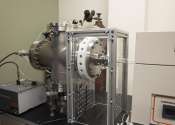Development of organic semiconductors featuring ultrafast electrons
Scientists have created conducting two-dimensional polymers exhibiting electron mobility comparable to graphene. Their research has been featured in the online edition of Chem.

Scientists have created conducting two-dimensional polymers exhibiting electron mobility comparable to graphene. Their research has been featured in the online edition of Chem.
Nanomaterials
6 hours ago
0
86

Plumbian orthoclase is a bit of a mystery, but this unique Aussie mineral is part of a mining industry revolution. The mineral's glowy green hue feels otherworldly. Although this Aussie kryptonite's origin is terrestrial, ...
Earth Sciences
6 hours ago
0
8

EPFL researchers have developed the first comprehensive model of the quantum-mechanical effects behind photoluminescence in thin gold films; a discovery that could drive the development of solar fuels and batteries.
Nanophysics
8 hours ago
0
35

A key feature of biological tissues is their inhomogeneity and their ability to grow via cell reproduction. To study this behavior, it is important to describe it using equations, which account for factors including growth ...
Cell & Microbiology
Apr 18, 2024
0
1

Cancer-causing flame retardants found in everyday things like plastics, furniture, fabrics and electronics can be sucked up by the skin and absorbed into the bloodstream in 24 hours, scientists have found.
Environment
Apr 18, 2024
2
22

The largest urban rewilding project in the U.K. is happening on an old golf course.
Ecology
Apr 18, 2024
0
1

Scientists are normally happy to find regularities and correlations in their data—but only if they can explain them. Otherwise, they worry that those patterns might just be revealing some flaw in the data itself, so-called ...
Analytical Chemistry
Apr 18, 2024
0
16

It is a common hack to stretch a balloon out to make it easier to inflate. When the balloon stretches, the width crosswise shrinks to the size of a string. Noah Stocek, a Ph.D. student collaborating with Western physicist ...
Nanophysics
Apr 17, 2024
2
14

A research team led by Dr. Serge Krasnokutski from the Astrophysics Laboratory at the Max Planck Institute for Astronomy at the University of Jena had already demonstrated that simple peptides can form on cosmic dust particles. ...
Astrobiology
Apr 17, 2024
0
102

Using a coffee grinder, a freezer and a furnace, researchers have discovered a chemical synergy between scrap tires and polystyrene can be harnessed to create sulfur-free, light oil.
Materials Science
Apr 17, 2024
0
1
cept
A chemical substance is a material with a specific chemical composition.
A common example of a chemical substance is pure water; it has the same properties and the same ratio of hydrogen to oxygen whether it is isolated from a river or made in a laboratory. Some typical chemical substances are diamond, gold, salt (sodium chloride) and sugar (sucrose). Generally, chemical substances exist as a solid, liquid, or gas, and may change between these phases of matter with changes in temperature or pressure. Chemical reactions convert one chemical substance into another.
Forms of energy, such as light and heat, are not considered to be matter, and thus they are not "substances" in this regard.
This text uses material from Wikipedia, licensed under CC BY-SA